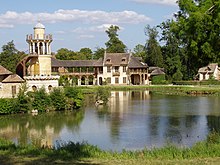Hameau de la Reine
The Hameau de la Reine , also known as the Queen's Hameau or the Queen's Hamlet , is an idealized village that was built at the end of the 18th century for the French Queen Marie Antoinette . It is located in the park of the Palace of Versailles in Versailles , France . Today the village belongs to the Palace Museum of Versailles and can be visited.
history
In 1774 the queen received from her husband Louis XVI. the pleasure palace Petit Trianon as a gift, in which Marie-Antoinette could withdraw from the etiquette and the strictness of the Versailles court life. In the next few years, the building was adapted to their needs. She also changed the garden area of the palace by transforming it into a park based on English models .
In Marie-Antoinette the desire arose for a small village to which she could occasionally withdraw. A hamlet - French hameau - was built for them east of the Petit Trianon from 1783 to 1788 by the Lorraine architect Richard Mique . The idea for such a staffage village was not new, the rural idyll was in vogue, life in the country was associated with the idea of freedom and beauty. At the end of the 18th century, philosophers like Jean-Jacques Rousseau also propagated a life close to nature. Similar fermes ornées already existed in other castle parks , the hameau in the park of Chantilly Castle served as a model. But here, near the Versailles residence , the most perfect complex of its kind was created.
With the hameau the queen made herself unpopular with her people. Her alleged extravagance had already earned her a bad reputation, and the idea that Marie-Antoinette indulged in "rural life" with silver rakes or small porcelain buckets annoyed not only the rural folk, who had to lead a completely different life. There was also a rumor that the maintenance of the village consumed a lot of money.
Marie-Antoinette was executed during the French Revolution , and the architect Richard Mique met the same fate. The hamlet fell into disrepair in the period that followed; however, it was restored around 1810 by order of Napoleon I.
Buildings
An ensemble was created around an artificial lake that was supposed to unite the various aspects of a farming village. The buildings are reminiscent of farmhouses from Normandy , but a precise stylistic classification is not possible and a realistic representation was probably not intended. The hamlet consisted of a dozen or so buildings that performed various functions; the most important house was that of the queen, the Maison de la Reine . There was also a farm, a mill, a fishery, a dairy and an observation tower, the Marlborough Tower . From 1785 Marie-Antoinette even had a family come from Touraine to keep the farm running and round off the atmospheric picture of their village.
The exterior of the houses was deliberately kept simple, but the interior design surprised with high-quality, luxurious furnishings that, of course, had nothing in common with the reality of rural life, which is full of privation. The Queen's house was furnished with a magnificent boudoir , had a billiard room and was connected to a ballroom via the wooden gallery.
literature
- Pierre-André Lablaude: The Gardens of Versailles. Werner, Worms 1995, ISBN 3-88462-117-3
- Jean-Marie Pérouse de Montclos, Robert Polidori: Versailles. Könemann, Cologne 1996, ISBN 3-89508-424-7
Web links
- Chateau de Versailles: The Queen's Hamlet (English)
- Video with French commentary (1:38 min.)
Coordinates: 48 ° 49 ′ 9 ″ N , 2 ° 6 ′ 49 ″ E



